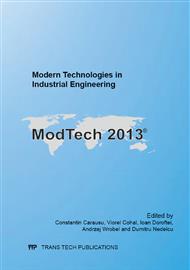p.296
p.305
p.310
p.316
p.322
p.328
p.334
p.340
p.346
Simulation and Performance Analysis of a FMS/CIM Using Stochastic Timed Petri Nets
Abstract:
This paper focuses on the modelling, simulation and the performance analysis of a flexible manufacturing system using stochastic timed Petri nets so as to evaluate various performance parameters such as utilization rate of machines, deadlock detection, cycle time, and throughput rate of system in order to obtain the optimum productivity. The simulation of the manufacturing system using Petri nets provides the possibility to view the manufacturing process in time. Petri net model is implemented in Petri Net Toolbox under MATLAB environment. It is achieved the graphic construction of the net. Then, transporting it into a specific mathematical formalism it is made, so that the fulfiled structure to be fully retrieved and used to bring out the internal dynamics of the model. It is validated in this way the net topology, the evolution of (their dynamics), as well as the structural and behavioral properties (corresponding to checking if resources usage is stable and the model have no deadlocks). Some global performance indicators are determined in order to evaluate the performance of the proposed manufacturing system.
Info:
Periodical:
Pages:
322-327
Citation:
Online since:
November 2013
Authors:
Price:
Сopyright:
© 2014 Trans Tech Publications Ltd. All Rights Reserved
Share:
Citation:


